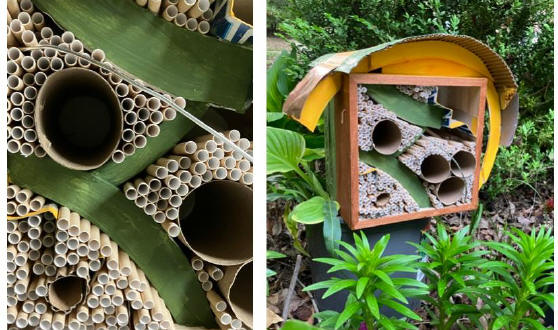Holly Solano
Adams County Master Gardener
(5/17) Building a garden sculpture is a great way to encourage visitors to interact in a garden. Who will live in a garden sculpture if designed as a pollinator house? Pollinators are insects that move pollen from flower to flower, helping plants set fruit and grow seeds. Flies, butterflies, and bees are important pollinators. Honeybees make up about 35% of bee pollinators; the rest of the busy buzzers are mason bees, orchard bees, other native bees. 80% of native bees nest in the ground, but mason bees and orchard bees are solitary and nest above ground in single tunnels. Building them a house that supplies building materials and a place to store food and lay eggs will help these native bees, and our gardens, thrive.

A pollinator house is a small structure that is designed to encourage aboveground solitary bees to nest. The open side of a pollinator house has many small tubes or drilled tunnels that allow each bee to select its own nesting tube. Bees prefer tubes made of breathable, natural materials, such as wheat straw, paper, or wood. The holes/hollow tubes need to be at least five inches deep and made of natural, breathable materials. Entomologists, scientists who study insects, have discovered that tubes shorter than five inches skew the sex of the offspring hatched. Each pollinator species prefers a different size tube; for example, mason bees prefer 8 mm holes. Research also shows that bees have an easier time finding their tubes if there are novel textures near the openings, as a sort of road map for their feet.
To build a garden sculpture that is also a pollinator house, find (or build) a softwood wooden box five or six inches deep, no bigger than a shoe box, and closed at the back. Use the box lid, scrap wood, or scrap metal to cut out and screw on a roof that will overhang the front and back of the pollinator house. It does not have to be a flat or rectangular roof. It can be any shape: use your imagination! Cover the outside of the box with aluminum duct HVAC tape or adhesive copper flashing tape. If the roof is made of wood, cover it with metal tape, too. Add a mounting bracket to the back, bottom, or sides, either for mounting poles or for securing to a tree or post.
Engrave designs on the metal-taped exterior and roof, using a dull pencil as a stylus. Paint the exterior any combinations of colors or metallics or leave it plain. Avoid painting the entire outside black, as black will overheat the bees. Then, design the inside. Use untreated scrap wood, thick cardboard, wire, and scrap metal to build a design that creates open spaces, or compartments, within the box. Be as creative as you want. A repeating pattern of bends, folds, wires, or sets of curves can help elevate a pollinator house to "pleasing sculpture" for us to enjoy. Use screws and a staple gun to secure compartment walls to inside of the box. Paint any compartment walls that protrude out past the box or roof. Do not use paint or polyurethane inside the box; the chemicals can harm the bees and encourage mold and parasites.
Finally, add the pollinator "apartments." In each compartment, place a bundle of breathable paper, corn, wheat, or grass straws of the correct size for the pollinator you want to host. Fill each space with straws (be sure they touch the back of the box) until they are filled in so snugly that they hold each other in place. Rubber bands may also be placed around bundles of straws before placing them in the compartment.
Choosing the best location for your completed sculpture will protect the bees and their brood. Be sure to place the sculpture so the front is not open to the prevailing wind, faces the sun to the south/southeast, has pollen source plants within 100 yards, and a mud source within 50 feet. Mount the sculpture securely on a post, two poles, or tree. It should not move in the wind.
Now you can admire the sculpture while the magic happens. In late summer and early fall, the bees will lay eggs in the tunnels. The mother will surround each egg with pollen or nectar and separate it from other eggs with leaves or mud. The mother will close off the tunnel with grass, mud, or tree resin to protect the eggs inside. The eggs will develop inside the tunnels over the winter, eating the pollen and nectar. In early spring, the bees will hatch and emerge from
the house, prepare to mate and start their life cycle all over again.
Leave the sculpture undisturbed. When placed in an appropriate location, above the snow line, you can expect a garden sculpture built this way to last two to three years. Once a year, after the pollinators have hatched in early spring, take out all the paper tubes in the compartments, and replace with new ones. This should ensure new healthy bees will hatch again, since tubes must be clean and free of mold and parasites for the babies to survive.
Read other articles by Holly Solano
Read other articles on birds, wildlife & beneficial insects